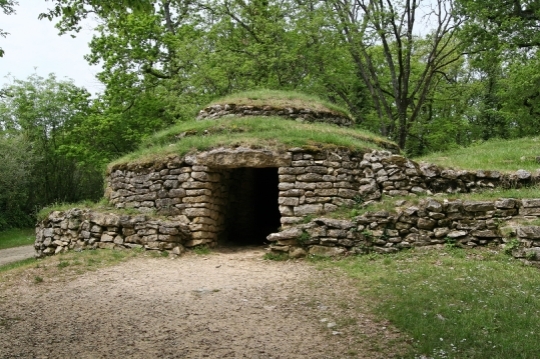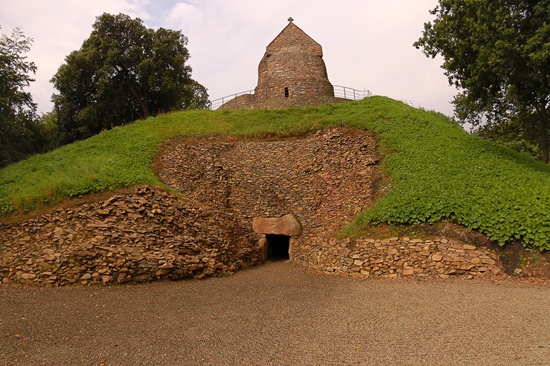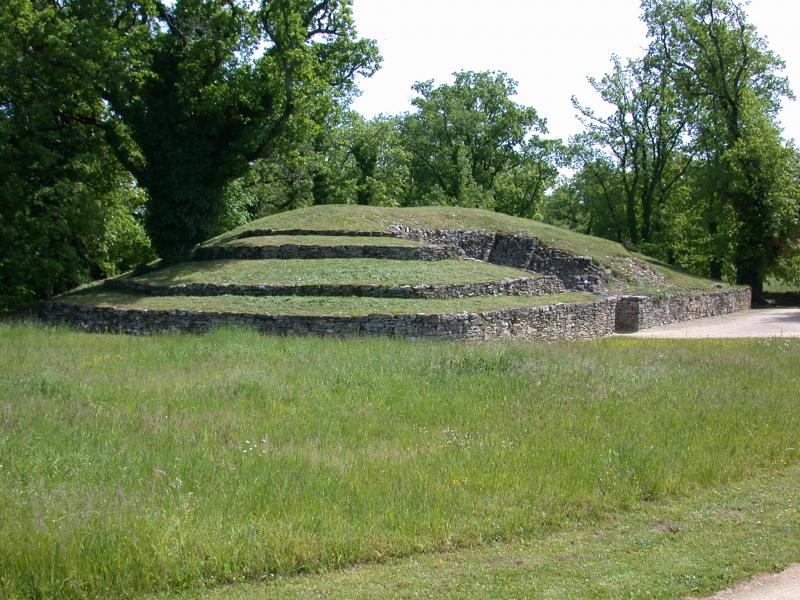The Tumulus of Bougon or Necropolis of Bougon (French: "Tumulus de Bougon", "Nécropole de Bougon") is a group of five Neolithic barrows located in Bougon near La-Mothe-Saint-Héray, between Exoudon and Pamproux in Poitou-Charentes, France. Their discovery in 1840 raised great scientific interest. To protect the monuments, the site was acquired by the department of Deux-Sèvres in 1873. Excavations resumed in the late 1960s. The oldest structures of this prehistoric monument date to 4800 BC.
The site is located on a limestone plateau within a loop of the river Bougon. The area used to be known as "Les Chirons".
Tumulus A
The stepped mound, erected in the early 4th millennium BC, has a diameter of 42 m and a maximum height of 5 m. Its large rectangular chamber (7.8 x 5 m, 2.25 m high) lies south of its centre. It is connected by a non-centrally placed passage. There is evidence that the passage was still used by the 3rd millennium BC. The chamber's walls contain artificially shaped orthostats, the gaps were filled with dry stone walling. The chamber is covered by a capstone which weighs 90 tons. It is supported by two monolithic pillars, which also serve to subdivide the chamber.
During its excavation in 1840, about 200 skeletons were discovered in three layers, separated by stone slabs. The vague reports of that early excavation prevent any detailed chronological analysis. Accompanying finds included flat-bottomed and round-bottomed pottery, beads, pierced teeth, chains of seashells and stone tools, including a diorite mace. More recent excavations showed that the grave was abandoned shortly after its construction. The passage had been blocked with a large stone slab. At its base lay the skull of a man who had undergone three trepanations during his lifetime. Pottery was also found in front of the monument's facade, suggesting that cult activities, entailing the deposition of pottery, took place after its closure. About 1,000 years later, the monument was re-used for more burials by people of a different culture who reached the passage from above.
Tumulus B
Tumulus B is a long mound, 36 m long and 8 m wide. It has four chambers. Two of them are very small cists, with no access passage. The mound's west part has two larger rectangular chambers, each accessible via a passage from the south.
Tumulus C
This circular earthen mound with a diameter of 57 m and a height of 5 m is a complex structure. It reached its final shape through several phases. The mound covers two earlier monuments:
a rectangular platform and
a smaller circular mound.
Structure D
A 35m long and 2 m tall drystone wall subdivides the Bougon complex in two zones, separating Tumuli E and F from the rest of the site. Several finds, including a piece of wood, proved the Neolithic date of this feature, unparalleled among the megalithic monuments of France.
Tumulus E
This doubly stepped mound, 22m long and 10 m wide, has two chambers accessible by near-central passages from the east. Originally, the chambers were contained in separate circular mounds.
Tumulus F
This trapezoidal long mound, 72 m long and 12 to 16 m wide, is the largest monument of the Bougon complex. Its west end abitted a pit that has been filled in since prehistory. The pit was the source of the material of which the mound (originally 3 m high) was built. The mound contains two chambers (F0 and F2), one at each end. Between them are seven different chamber-less structures (F1).
Synopsis
The 1,000-year development of architecture at Bougon can be subdivided in three phases:
round or oval mounds with corbel-vaulted chambers
elongated mounds with small rectangular megalithic chambers
large rectangular megalithic chambers
Bougon Museum
The Bougon Museum, opened in 1993, is a modern structure, incorporating an ancient farmhouse. The exhibition is focused on prehistory in general and the Neolithic in particular. It includes the excavated material from the site, but also replicas of a room in the Neolithic settlement of Catalhoyuk (Turkey) and of the passage tomb art from Gavrinis (Brittany). The museum also has an outside area with displays of experimental archaeology, including reconstructions concerned with prehistoric methods for the transport and construction of megalithic monuments.













